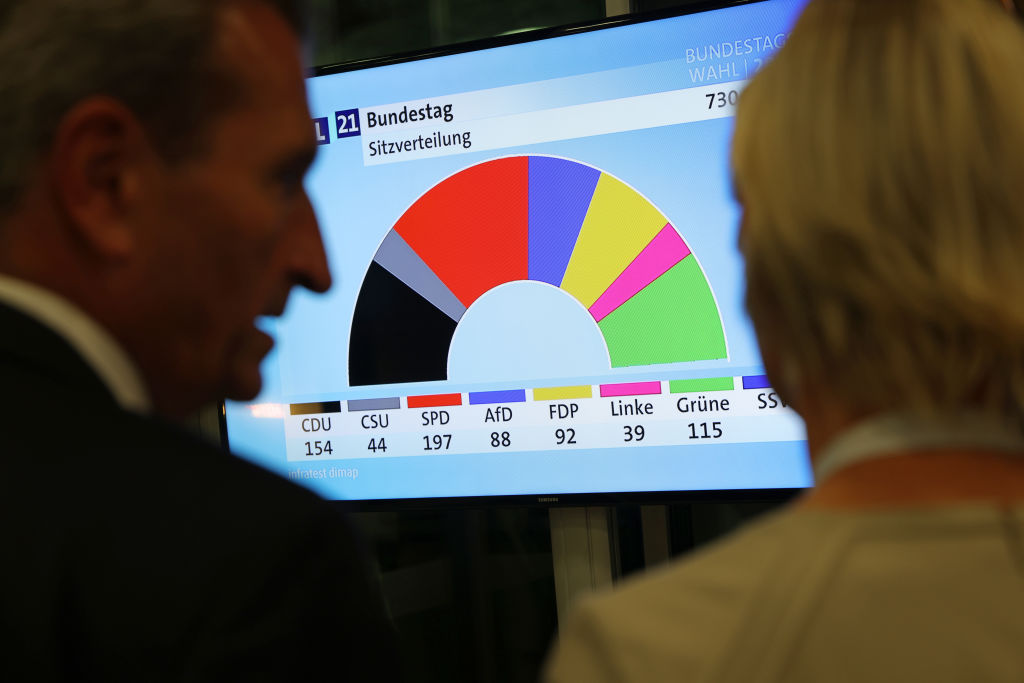The German elections have turned out to be an unexpected nail-biter. Since the exit polls were released earlier this evening the result has been too close to call. Angela Merkel’s CDU/CSU and their coalition partners, the SPD, are both predicted to have received 25 percent of the vote each, which means it will remain unclear throughout the evening who has won as the votes continue to be counted.
Despite the close result, the mood in the Christian Democratic camp is subdued. Angela Merkel’s would-be successor Armin Laschet has received the worst result his party has achieved in its history. The exit polls showed that 1.4 million of their voters switched to the Social Democrats this time and a further 900,000 migrated to the Green party. Instead of comfortably winning the election, as originally expected, the party will now have to fight for the chancellorship in tough coalition talks.
Meanwhile, there was loud jubilation at the SPD headquarters in Berlin, the Willy Brandt Haus. Only a few weeks ago, the party was straggling behind, at around 15 percent, but their chancellor candidate Olaf Scholz led a successful campaign in which he presented himself as Merkel’s natural successor and a safe pair of hands. His party will now claim that it has the right to provide the next chancellor given the desire for change, indicated by the result.
With both of the main parties neck and neck, the smaller parties will become potential kingmakers. The Greens will achieve around 15 percent according to the exit polls, a huge increase from the 9 percent they reached last time but also a long way off the highs they had of 30 percent back in the spring. The Free Liberals came in at 11 percent, a good result for them. They have already expressed a strong desire to sit on the governing benches rather than go into opposition again, which might see them compromise some of their core libertarian principles in exchange for power.
A left-wing coalition of the SPD with the Greens and the far-left Die Linke, which was constantly conjured up by the CDU/CSU as a specter to scare centrist voters, now seems unlikely. According to the exit polls and early counting, Die Linke came in at 5 percent which means it still has to fear whether it will be admitted to the Bundestag at all, as Germany’s post-war constitution established a 5 percent hurdle. If parties fail to match this, they will not enter parliament in order to avoid the type of political splintering that undermined the Weimar Republic in the 1920s. Even if Die Linke makes it in, their numbers are currently too small to push a coalition with the Greens and the SPD over the 50 percent mark.
The Alternative für Deutschland (AfD), an anti-immigration and anti-lockdown party, also came out as a significant force again at 11 percent, only slightly lower than the 13 percent it reached last time. Then, their result was interpreted as a consequence of the refugee crisis of 2015, in which Merkel’s decision to open German borders to Syrian refugees allowed well over a million people into the country. It seems now that the party is here to stay even if all other parties have said that they will not enter into coalition negotiations with them.
Despite the uncertainty of the results, the early figures have already thrown a few spanners in the works. While the left-wing coalition of the SPD, Greens and Die Linke now seems improbable, a ‘grand coalition’ of the CDU/CSU and the SPD is back on the table — at least in theory. The two established parties have run the country together since 2013 but would form an extremely slim majority and one that would not seem to give voters the change they clearly want.
The two most likely options — and they would produce nearly equal numbers in the Bundestag — would be either a coalition led by Armin Laschet which includes the Free Democrats (FDP) and the Greens. This ‘Jamaica coalition’ (so named as the colors of the parties match those of its flag) would be a centrist alliance with a focus on the economy and climate change over social issues. The FDP has explicitly named this as their favorite outcome and will put pressure on the Greens to achieve this.
The other option is a more left-leaning ‘traffic light’ coalition led by the SPD’s Olaf Scholz, who would ask the Greens and the FDP for support. This coalition would also push a climate change agenda but it would also press for state-led social programs, which would sit uneasily with the economically libertarian FDP.
We are in for a long evening as the votes are still being counted. In addition, nearly half of the German turnout consists of postal votes, which have naturally not entered the exit polls at all and will now have to be counted by hand. This might well still change things significantly, as it is expected that more older voters are among them: bad news for the Greens.
With results this close, it will be a long night for all parties involved and for a nervous German population waiting to see what the post-Merkel era looks like. After an uninspiring election campaign, the tension of the election night itself has created a temporary flurry of excitement in the country. Yet when the dust settles, voters will still be left with the same uninspiring offering.
This article was originally published on The Spectator’s UK website.


















